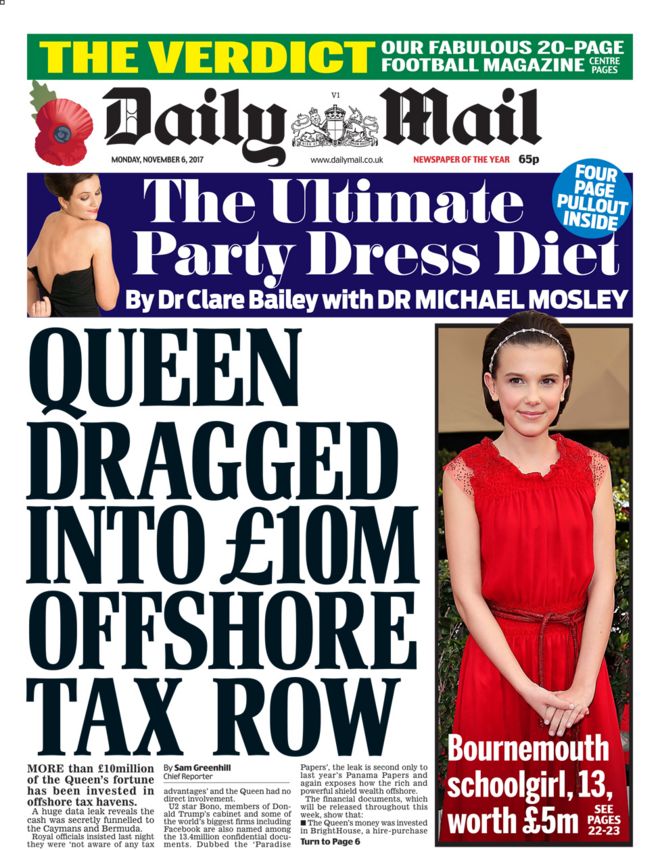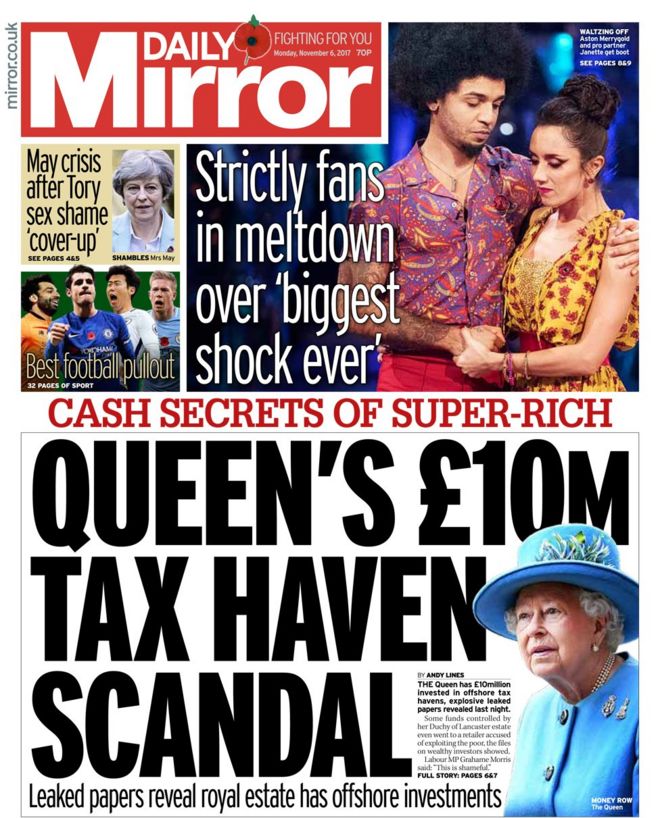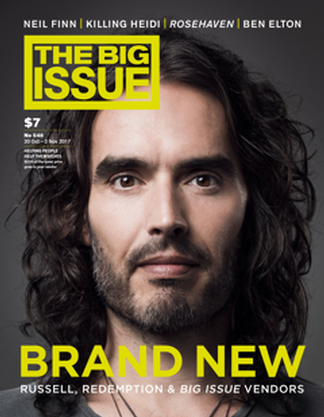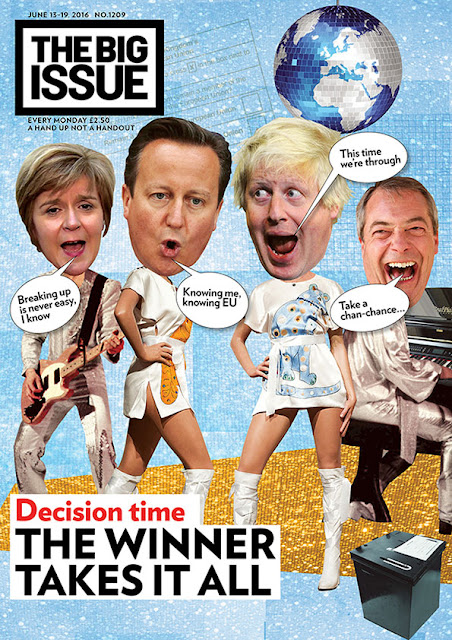THE PARADISE PAPERS CASE STUDY
E.g. The Guardian


These two front page covers from the Guardian and the Daily Mail, both covering The Paradise Papers story. The differences between the papers represent the ideologies that each paper follows. The first main difference between the two front covers is the amount of information given. The Guardian follows typical broadsheet values, including large amounts of copy within the front page. However the tabloid style of the Mail creates a simple front page, including only the masthead and a small section of copy which continues over onto a following page.
These are further examples of more coverage on the breaking story, showing how each different newspaper presented the story from their own ideology. In all of these examples, the Queen is made the main focus. Though the Daily Mirror and the Daily Express both present the story from different perspectives, almost like the Daily Mail and the Guardian. Firstly the Daily Mirror uses the noun 'scandal', here making the Queen seem guilty; as well as the 'super-rich'. This is the typical left-wing political viewpoint, where they are supportive of equality across society; hence agreeing with the process of taxing percentages or peoples wages, rather than a set amount. Though the Daily Express victimises the Queen, referring to her money as her 'fortune'. This right-wing royalist approach to their article makes it very clear to any reader that they are supportive of the Queen, no matter what situation she is in.
Media Language
On this Guardian front page, covering the first release of the story on the Paradise Papers, there is a clear colour theme. The use of a bright and bold colour like yellow makes the story stand out compared to the usual monochrome front cover page; this use of yellow could represent the gold colour of money or the sun in 'paradise'. The colour is repeated throughout the articles within the front page, helping to highlight the main elements and images. This use of smaller articles at the bottom of the page help to back-up the main article, providing readers with a deeper understanding of the topic by including related articles, almost like evidence for their viewpoint. As well as this, the overall layout of the paper is easy to take-in, with each aspect spread-out so to make sure the front cover page doesn't look crowded. Though the editor has still made sure to include a large amount of copy at the bottom of the page, using the Berliner format to make sure as much information as possible is given.
Media Industries
The entire newspaper supports the left-wing communist ideology, using negative language like 'controversial' and 'accused' to display the opposing viewpoint. The main image used also helps to present the opinion of the Guardian clearly, showing their unsupportive view towards the royals and the queen. This use of bias and dominant ideology throughout the articles helps to aid the readers views as they are supported by the paper they read and invest in.
Media Audience
The use of language through this Guardian front page cover uses the same ideologies as which the reader agrees with. This socialist viewpoint is expressed throughout these article, almost ironically given the capitalist reasoning behind the story. All newspapers express this pro-capitalist approach to their coverage, though left-wing newspapers like the Guardian also show aspects of socialism. Therefore, by covering their articles with this ideology it is appealing to their audience as they agree with the same opinions. The 'Uses and Gratifications' theory links into this, using the role of the audience to advantage their publications. Similarly a high percentage of the Guardian's readers view their news online, meaning that the interaction which they can have with their readers is much greater compared to a newspaper like the Daily Mail who has a higher percentage of readers who read the physical version of the Mail.
Media Representation
One of the Guardian's main ideologies which they follow throughout their articles is the backing of equality between social classes. This viewpoint argues in favour of the poor, oppositely, being unsupportive of the Queen. This ideology is popular among readers as the public are who are truly experiencing how the upper classes dodging taxes affects their lives and services. This whole front page which the Guardian produced on this Paradise Papers story criticises the capital; the images used almost ironically of the Queen's head, also used on stamps and Britain's currency. As well as this, the main image used also represents the establishment of money, linking in to the main topic of the following articles. Finally the creation of the simple paradise Paper's logo which is used on the four Guardian front cover editions, therefore making it clear to the reader that more information has been found on this story. The logo, in the matching yellow colour, of a sunset over a sea; represents a 'paradise'. The use of this tropical theme within the logo helps to represent the 'perfect' offshore locations in which are being used to exploit Britain's tax system.


These two front page covers from the Guardian and the Daily Mail, both covering The Paradise Papers story. The differences between the papers represent the ideologies that each paper follows. The first main difference between the two front covers is the amount of information given. The Guardian follows typical broadsheet values, including large amounts of copy within the front page. However the tabloid style of the Mail creates a simple front page, including only the masthead and a small section of copy which continues over onto a following page.
The language used within each masthead is almost politically opposite, with the Mail's right-wing ideology backing the Queen, claiming how she was 'DRAGGED' into the 'TAX ROW'. The use of the negative verb 'dragged' victimises the queen, making their royalist ideologies very clear. Oppositely, the Guardian's use of masthead is unsupportive of the Queen, as well as criticizing the capital. The use of the yellow circular image, representing a coin is used to represent the establishment; all of which is controlled by the Queen, with ironically her head on. Therefore this socialist ideology which the Guardian presents means that within this news story especially, the paper will be very keen to do a large coverage, as their audience share the same viewpoint, agreeing in equality.
Similarly, the Guardian also includes a logo format on their front page, this then follows through the next three editions of the paper as the story slowly becomes insignificant. The Guardian has used this logo very cleverly as it is also in the same bold yellow colour, showing a setting sun over a ocean. This, along with the title of the story: 'The Paradise Papers', helps to present a very clear image for the audience. The thinking behind the logo may referring to how these offshore locations are 'paradises' compared to the UK, or an ideal. The Guardian's reasoning behind their larger coverage on this story, compared to the Daily Mail, is due to their socialist ideology. This means that they will want to present this story as negatively as possible to their audience, making it very clear that this is another event which has shown those high up within the country breaking their own rules, agreed with by socialists.
E.g.
E.g.
Though by comparing these two papers with the Daily Mail and the Guardian, it is clear that they don't deem this story as important. The Daily Express makes the weather their main masthead for that edition, this looking almost comical, with a smaller image of the Queen in the bottom right corner. Similarly, the Daily Mirror's front cover presents this Paradise Papers story as important as the Strictly result. The page is split in half, and even though the main bold masthead is about the tax scandal, the colourful image above of two Strictly contestants seems to catch the reader eye more.
Both of these papers are examples of a tabloid style of print, therefore these types of papers tent to be more entertaining with less academic information given. Though even the Daily Mail, another tabloid newspaper presents this story as the clear major headline of the day.




Comments
Post a Comment